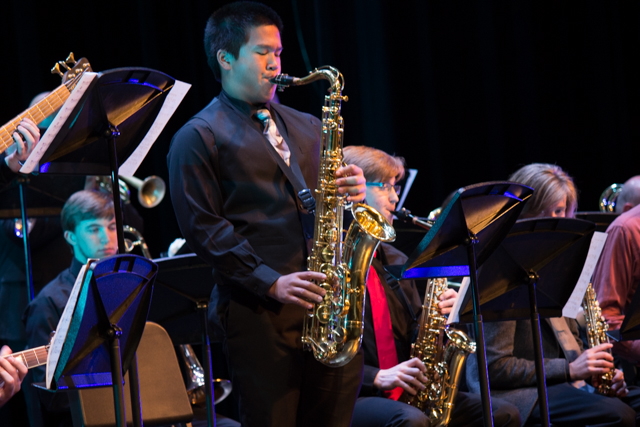The Las Positas College Actors Conservatory, also known as the ACLPC, has just launched its guinea pig cohort into the world of performing arts, whether they transferred into four-year institutions or went directly into the acting industry. With a certificate from the Actors Conservatory, you can do both.
According to the program director, Titian Lish, the Actors Conservatory is a “two-year dedicated training program for people who are interested in either pursuing a career in acting professionally or love it as a hobby and want to get training.”
“We want to make space for those people to be able to come back and have a second act in life where they get to do this other part of their identity,” Lish said.
Compared to the other college acting conservatories, the ACLPC advertises an up-to-date and encompassing performing arts education at a very low price. Many people cannot pursue a creative passion for the sake of financial circumstances. According to a 2017 New York Times survey, 53% of 20 year-olds pursuing creative fields receive financial aid from their parents, versus 47% of careers relating to science, technology, engineering and math. On the other hand, only 29% of students pursuing agriculture, construction and retail receive parental aid. Overall, pursuing a creative field is not a viable financial prospect, which is why many individuals turn away from it.
However, the theater arts education offered at the community college level makes those dreams affordable. According to 2020-2021 yearly tuition costs for Las Positas, in-state students spend an average of $1,168 on tuition. Considering how 40% of students receive state and local grants worth an average of $2,254, conservatory students pay slightly above average tuition, around $1,936-$2,016 per year.
“It feels fiscally irresponsible to force students to pay a ton of money to get better at a passion,” Lish said.
In addition to its modest cost, the conservatory has no audition process, making it stand out among typical conservatories. As Lish puts it, to have to audition into an actors conservatory is, at its fundamentals, gatekeeping. To apply to LPC’s program, one must simply fill out an application and take a conservatory readiness class.
That said, Lish noted how “you had to be able to have a large amount of financial resources and be really good at this thing already.”
ACLPC began as a project dating back to 2017. Lish noticed a trend of students in theater classes wanting a streamlined path to pursue acting seriously, which culminated in the idea of a conservatory environment, as she remembered her own college conservatory experience valuably.
“In a conservatory environment, you work with a specific group of students, typically called a cohort, and take all of your classes with that cohort. Instead of taking science or math class in an acting conservatory, you take acting in history and things that are relevant to your development as a performing artist,” Lish said.
Lish then began to interview recently graduated students who transferred to universities, some with conservatory programs, or who were already working in the industry. She researched other colleges around Las Positas and California and what they were offering, alongside training programs in Los Angeles, New York and Seattle. To create the conservatory, new classes had to be created and existing ones readjusted or even removed. Such new classes included Shakespeare, Stage Combat, Acting for the Camera, Voiceover and even a class for the Business of Acting, in which students could learn how to work with agents and file taxes.
There is only one other community college actors conservatory in California: the Pacific Conservatory at Allan Hancock College. Lish says, “I felt really inspired by their program. They had a lot of success bringing students in to do 2-year training and then going out working professionally or taking those credits and transferring to a four-year.”
In the Bay Area, there are over 400 theater companies. With such a bustling theater culture, it’s surprising there was no affordable conservatory program in Northern California before Las Positas implemented it.
Although Las Positas is small in comparison to four-year universities, the conservatory is just as rigorous. The University of California and California State University transferable curriculums are finely tuned to encompass acting, musicality, movement and business in the performing arts. Though, in order to incorporate each subject, conservatory students keep busy.
The first semester entails the most rigorous schedule as an introduction to the conservatory lifestyle. Students are required to take 16 units, which is near the maximum units you can take as a full-time Las Positas student.
In the words of Colin Fitzmaurice, a conservatory graduate, “The first semester eliminates those who can’t handle it.”
The two-year plan schedules classes from Monday through Thursday from 9 a.m. through 4 p.m. Overall, the first year of the program sets up the foundation for solid acting skills, while students showcase their knowledge in the second year. In their second year, students are required to perform in two to three productions and an end-of-year showcase for Bay Area directors.
Second-year students are more likely to realize their potential and push themselves further. Many of the cohort students were leads in school productions, like “Peter and the Starcatcher” and “High Fidelity.”
The first cohort of the Actors Conservatory, consisting of eight students, graduated in the spring of 2022. Liva Langer, a student who was part of that graduating class and transferred to UC Santa Barbara as a theater major, commends the program,
“I think what’s most valuable about the Actors Conservatory is you’re not getting taught by people who don’t understand what the industry is like. These are people who are currently working in the industry, whether they’re acting or directing.”
As Langer acknowledged, students get an accurate and realistic picture of what the acting industry will be like when they graduate, which is especially important for finding an agent or joining a union. On top of that, they have opportunities for networking in the theater world.
What was more invaluable than the conservatory resources–audition opportunities, free tickets to shows and discounted professional headshots–according to the cohort graduates, was their learning experience. The quick and relentless schedule of the conservatory, such as having to go straight from a sweaty fencing class to acting for the camera, is reflective of the real acting world, where one is constantly pushing themselves.
“People underestimate how much action it takes to do an acting career. It’s physical and mental. I’ve been told by the end of a scene you should be out of breath,” Langer said.
The conservatory would not be able to provide for students if it wasn’t for its faculty, in particular, Titian Lish. Langer was connected to the Las Positas Barbara Mertes Scholarship through Lish and now her UCSB tuition is fully covered by the fund.
“Lish really cares about her students and goes out of her way to help them. She helped me find ‘my best actor.’” Fitzmaurice said, who is transferring to CSU Long Beach as a performing arts major.
Dyan McBride, who teaches most of the Las Positas theater classes alongside Lish, has helped students tremendously as well.
“McBride helped me a lot with my singing capabilities and understanding that you’re always acting, especially when singing,” Fitzmaurice said.
Aside from McBride and Lish, the guest professors brought into the conservatory classes introduced new perspectives to the craft. Guests included a stage combat professional from the Oregon Shakespeare Festival, actors in the Bay Area and other performing arts specialists. Conservatory graduate Matt Bessiere saw improvement with help from several of these guests.
“I’m much more confident in audition situations and a lot more prepared to present myself as professionally as possible,” Bessiere said, who is pursuing acting in LA.
As the program becomes more popular, Lish intends for more classes and cohorts to be offered. Piloting this fall is a mental health program specifically for theater students. This includes a monthly chill and chat series and drop-in mental health counseling that works in the conservatory schedules.
“It’s hard to be in an industry like performing arts where you’re putting yourself out in front of people all the time and then be vulnerable,” Lish said.
All in all, Langer, Bessiere and Fitzmaurice all agreed that if they had to enter the acting industry now, the Actors Conservatory had fully prepared them.
“It was definitely hard work, but there were those rewarding moments of ‘oh I finally nailed that scene’ or ‘I just went to that audition and because of that class I took, I did so much better.’ Those are the things that make you realize ‘oh I really needed to suffer through that class to learn about myself and my work ethic,’” Langer said.
Students can still apply for the conservatory but there is limited time. Applications for the 2022 incoming cohort are accepted no later than Aug. 23.
“I believe everybody has the right to access the ability to learn. If we remove that access, who’s to say we’re not removing great artists from our industry,” Lish said.
Lizzy Rager is the managing editor for The Express. Follow her @ragerlizzy.
Correction: This article was corrected on Aug. 23, 2022, at 11:52 a.m. The acronym LPCAC was changed to ACLPC.




